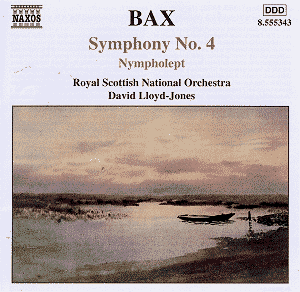The Naxos cycle continues and this instalment is to
be warmly greeted.
Overture to a Picaresque Comedy: a Straussian
panache swoops, strides, struts and serenades its way through this euphorically
pell-mell interpretation of Bax's whooping slalom run. This is not top-drawer
Bax but it shows his craftsmanship in colours that are wild, garish,
non-Russian, non-Nordic and voluptuous. Bax is out to emulate Richard
Strauss's Till Eulenspiegel and Aus Italien with a dash
of Cockaigne's bustle and a wink and nod in the direction of
Dukas and Holst's Perfect Fool. The same vein can be discerned
in the first and last movements of the Violin Concerto and in Work-in-Progress;
the latter recorded years ago by Lyrita Recorded Edition and never
issued.
Nympholept is dedicated to Constant Lambert
whose Pomona woodland ballet takes a cooler and more classical
perspective. Bax's rarely performed work is a woodland idyll - a sylvan
analogue to Balakirev's Tamar. The woodland scene is fleshed
out with nymphs and satyrs of beguiling ways. This is a Swinburnian
fantasy with links to the George Meredith and the Pre-Raphaelite painters.
Bax continued the vein with works such as Spring Fire and The
Happy Forest. Nothing is quite that simple but this work might well
be grouped by reference to Edward Burlinghame Hill's Prelude,
d'Indy's Jour d'Eté dans la Montagne, Roussel's Symphony
No. 1, Ravel's Daphnis and Prélude à l'après-midi
d'un faune. The music rustles and writhes with the seething forest
shadows and the dappled dazzle of summer.
Neither the overture nor Nympholept are first
recordings. Bryden' Thomson's Nympholept is with the Second Symphony
(and no other coupling) on a Chandos CD in which the textures were rendered
far too densely and are over-warm and clouded. The Overture was recorded
by RCA many years ago when the conductor was Igor Buketoff.
The Symphony No. 4 is a discursive fantasy work that
stands midway in Bax's symphonic journey from terse tragic epic to elysian
lyrical Armageddon to Celtic wonderland and thence into the gloriously
Sibelian fastnesses of the Fifth and Sixth symphonies. It has the marine
rapture of the Seventh Symphony without its valedictory placidity -
some might say complacency. If he had dubbed it Sea-Phantasy we
would not have blinked. Its tendency to bask is heard at zenith in the
lento moderato and is prevalent in the allegro moderato which
for music of its time is more moderato than allegro. The
finale is the shortest of the three movements. Lloyd-Jones takes things
expansively with the long fade at the end of the middle movement seeming
to evoke a sun-drenched rock reef at the end of an uttermost skerry.
In the finale, which also goes pretty steadily, I have never heard the
little harp and flute dance at 7.34 done with such rare poignancy. There
are many passages here which seem to be a gift to the brass section
and especially the eight horns prescribed. The RSNO's men of brass rise
fulsomely to the challenge and the great peroration to the finale goes
with a confident blare and a crest-rolling roar. Comparing this with
Bryden Thomson's version on Chandos with the Ulster Orchestra I have
to lean marginally in favour of the Thomson with its fleet eagerness
and its tendency to move forward even through the dreamy episodes. The
more I listen to and write about this work the more similarities I perceive
with another 'sea symphony' Hugo Alfvén's Symphony No. 4.
The Fourth was dedicated to Paul Corder (see the
biographical sketch in my review of Swinsty's recording of the Preludes
for piano). It was premiered by the conductor Basil Cameron with the
San Francisco SO in 1932. Cameron also conducted a sturdy and savage
performance of Bax's Northern Ballad No. 1 for the BBC in the
1950s. Sibelius was close to Cameron's heart and there are several Tapiola-like
moments in this work.
Only numbers 6 and 7 to go now and I do hope that 6
is next in line. After that can I implore that Naxos look out Winter
Legends if they have a young unknown and brilliant pianist who is
superior to the challenge and is prepared to tackle something that is
not called a concerto.
Rob Barnett


